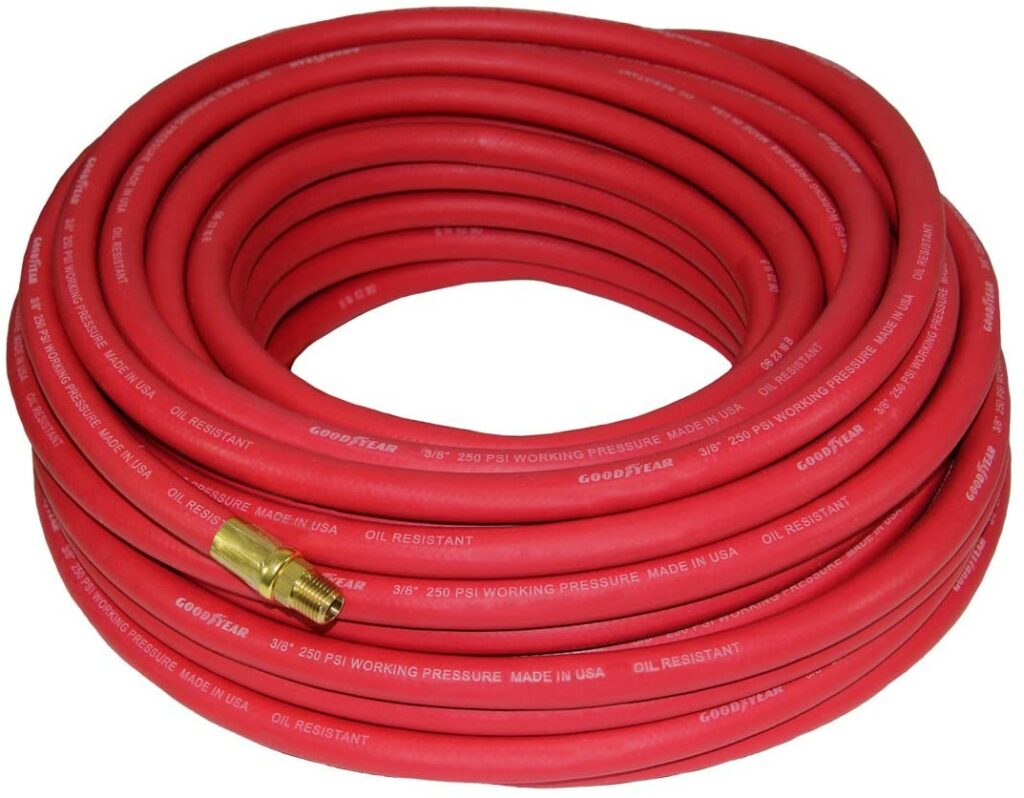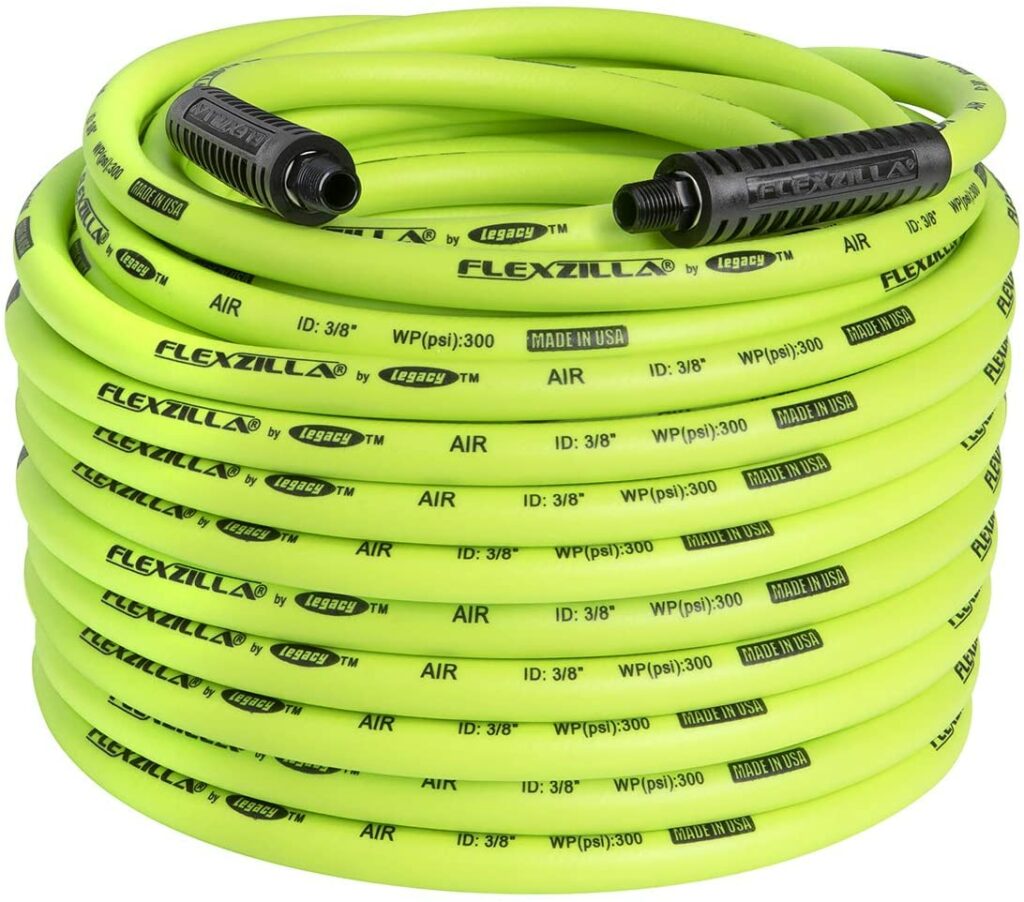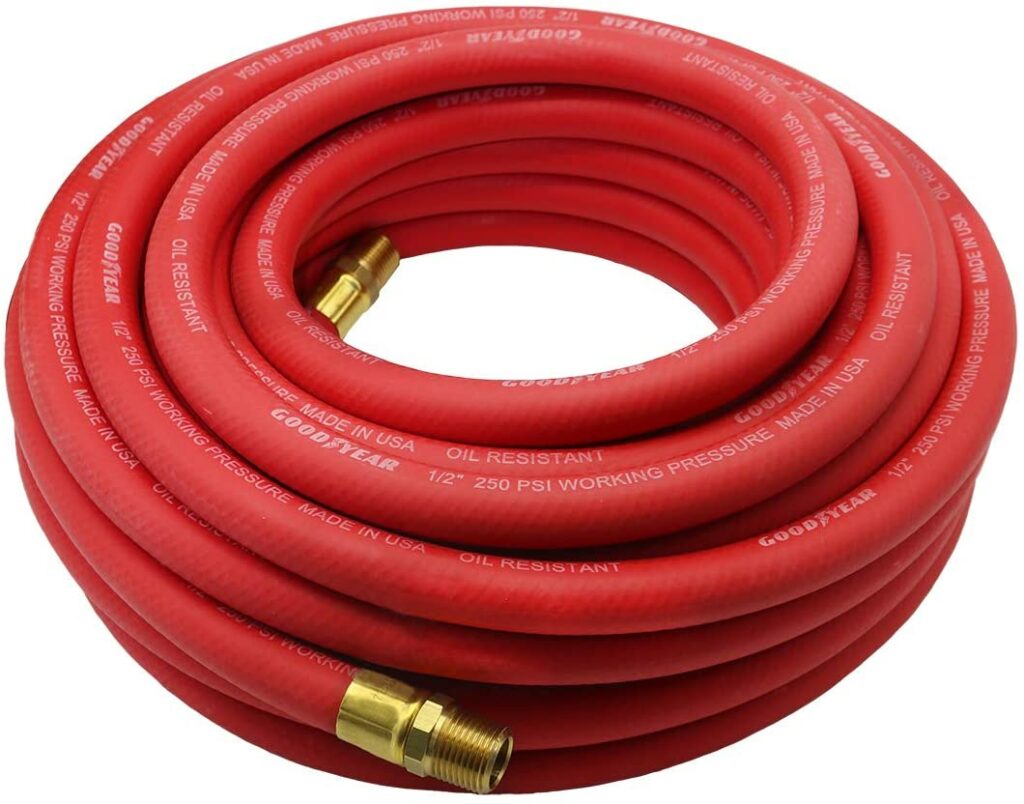Are you confused between getting a ⅜ air hose vs a ½ air hose? We went ahead and did a detailed comparison to make the choice easier for you!

3/8 Air Hose vs 1/2 Air Hose – Which One Is Best?
 Are you looking to buy a new air hose? You’re in the right place! The first question is, what are air hoses? The answer is simple: air hoses carry compressed air.
Are you looking to buy a new air hose? You’re in the right place! The first question is, what are air hoses? The answer is simple: air hoses carry compressed air.
Underwater divers use air hoses to transport air from a surface pump or air tanks. These air hoses must be incredibly powerful to withstand high pressures and avoid leakage or injury. They are mostly made of rubber, silicone, or metal.
Additionally, oil-based lubricants are often applied to compressed air to ensure that the machinery runs smoothly. As a result, these air hoses must be oil-resistant. Rubber is used to treat high-pressure and oil-based lubricants.
Remarkably there is a stack of models available in the market with advanced features to provide the users with a worthy experience.
After detailed analysis, we have found the best air hoses for you.
3/8 vs 1/2 Air Hose
⅜ and ½ are not air hoses. These are only particular sizes of hoses. Each one has its particular properties, which include:
| Properties | 3/8 Air Hose | ½ Air Hose |
| Hose Internal Diameter | 3/8 inch | ½ inch |
| Hose Length | 50 ft. | 50 ft or 100 ft |
| Material | Premium Rubber | Rubber |
| Hose Outlet | 1/2 in. MNPT | 1/4 in. MNPT |
| Working Pressure at 70°F | 250 PSI | 300 PSI |
Selecting Particular Hose
If you have never bought an Air Hose before, you’re probably feeling lost. Since there are several options available, it is harder for the user to select the one they want.
Don’t worry! Choosing the best air hose isn’t challenging anymore once you read our detailed analysis. Let’s get right into the business!
1. Length of Hose
 First of all, consider the length of the hose.
First of all, consider the length of the hose.
The standard lengths of air pipes are 50 and 100 feet. A 100-foot hose is more comfortable when in operation, and it can stretch farther. However, in some situations, a 50-foot hose is a safer option.
A ⅜ air hose comes in 50 ft and 100 ft, but the ½ hose only comes in 50 ft.
Most commonly, long compressed air hoses are used for larger tasks, for example, painting a car. On the other hand, a short compressed air hose should suffice for a fixed workstation with fewer motions. Here are a few options for you to consider:
Flexzilla Air Hose is a ⅜ Air Hose with 100 ft length.
Good Year Air Hose is ⅜ -Inch Air Hose with 50ft length.
Goodyear Red Rubber Air Hose is a ½ -Inch Air hose with 50ft length.
2. Hose Diameter
Inner Diameter determines the size of the hose. However, this does not imply that the air hose’s inner and outer diameters are the same.
The hose wall’s width and the presence of a supporting coating define its outer diameter.
½ inch and ⅜ inch are the most often use sizes in practical applications. Air hoses with a diameter of ½ inch are best for air tools and do not require high pressure or mass air transfer—for example, an air paint sprayer.
If you need an air hose for your pneumatic hammer or mining tools, then a ⅜ air hose would be the best choice! We don’t recommend getting a hose with a diameter of fewer than ⅜ inches.
3. Material
The material is one of the most critical factors when selecting a hose.
It has an impact on its weight, durability, and versatility. That is why it is essential to understand its variations before you purchase a new hose.
If you intend to use the hose in a generally cold space, choose a material designed to remain flexible. Most of the hoses are of rubber, nylon, silicone, and PVC. Let’s get a little deeper:
-
Rubber
Rubber is the most widely used composite for air hose.
These hoses are solid, durable, and long-lasting. That is why they can withstand a wide variety of heat and temperature variations.
Particularly in the middle of winter, the rubber will remain soft and flexible. Sounds impressive, right?
However, rubber is heavier than most materials. That makes such air hoses unsuitable for use on the roof since they could fall off because of the weight.
-
PVC
PVC is a long-lasting and abrasion-resistant material. A PVC hose is one of the most cost-effective alternatives. It isn’t as adaptable as the other varieties, but it’s perfect for operating in hot climates.
You cannot use PVC hoses in cooler temperatures because they are more likely to twist or break.
-
Other materials
 Nylon hoses are abrasion resistant and have good dimensional stability with low permeability.
Nylon hoses are abrasion resistant and have good dimensional stability with low permeability.
Similarly, a Polyurethane air hose, also known as poly hose, is an “all-around” choice. It’s lighter than the equivalent hybrid and PVC alternatives. It is also adaptable to a wide range of working temperatures.
Environmental conditions such as UV rays and harsh weather make rubber and PVC hoses unsuitable.
When choosing a hose for your application, keep the outside environment in mind. When it comes to systems that are subject to UV rays, silicone hoses are much safer alternatives.
4. High Temperature
The temperature a hose can handle is an essential factor and should be one of your top priorities.
First of all, you have to be sure of the places you will use the air hose. Hoses have different temperature ranges within which they perform best.
Polyurethane hoses function well in temperatures as low as -22° F. Neoprene hoses are more expensive than nylon hoses, but they can withstand temperatures as low as -4°F. The ⅜ -inch Flexzilla Air Hose can withstand a temperature range from –40 Degree to 140 Degree F. It is the best air hose for multiple uses.
5. High Pressure
Metal hoses are considered the best with regards to pressure. They can easily withstand high pressure and oil-based lubricants.
In large compressors, air molecules constantly collide due to high pressure. That causes excess production of heat. This heat degrades the rubber hoses and reduces their service life. Those are some of the reasons why most users prefer metal hoses for high-pressure applications.
Conclusion
½ air hose and ⅜ air hose both have their specific features and specific uses. ½ air hose is perfect for smaller projects like air sprayer, while the ⅜ hose is ideal for heavy machinery.
We hope the above features help you choose the best air hose for your needs. Make sure to keep these factors in mind when you purchase a new hose. This helps ensure that you get the best deal out of your money.
